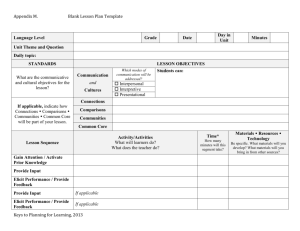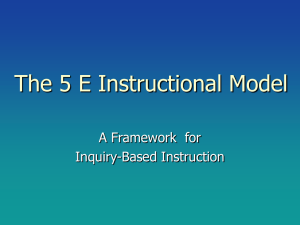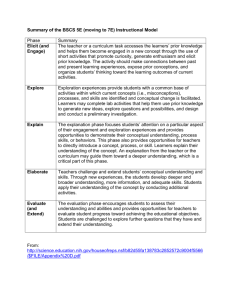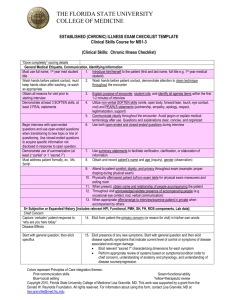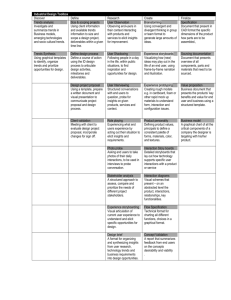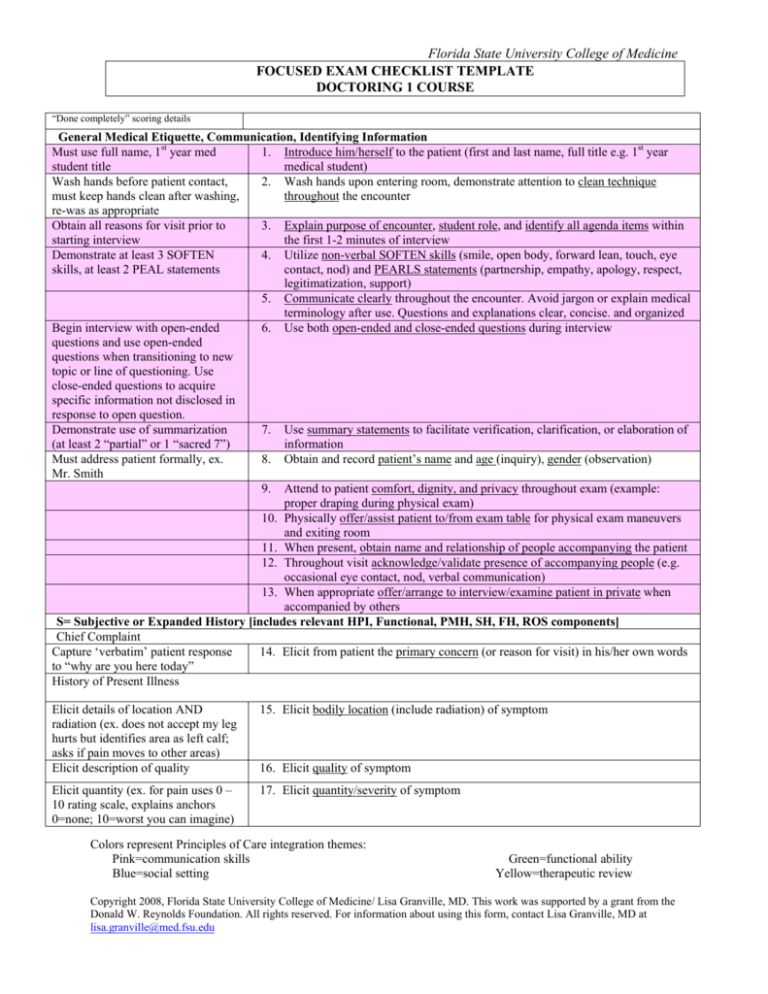
Florida State University College of Medicine
FOCUSED EXAM CHECKLIST TEMPLATE
DOCTORING 1 COURSE
“Done completely” scoring details
General Medical Etiquette, Communication, Identifying Information
Must use full name, 1st year med
1. Introduce him/herself to the patient (first and last name, full title e.g. 1st year
student title
medical student)
Wash hands before patient contact,
2. Wash hands upon entering room, demonstrate attention to clean technique
must keep hands clean after washing,
throughout the encounter
re-was as appropriate
Obtain all reasons for visit prior to
3. Explain purpose of encounter, student role, and identify all agenda items within
starting interview
the first 1-2 minutes of interview
Demonstrate at least 3 SOFTEN
4. Utilize non-verbal SOFTEN skills (smile, open body, forward lean, touch, eye
skills, at least 2 PEAL statements
contact, nod) and PEARLS statements (partnership, empathy, apology, respect,
legitimatization, support)
5. Communicate clearly throughout the encounter. Avoid jargon or explain medical
terminology after use. Questions and explanations clear, concise. and organized
Begin interview with open-ended
6. Use both open-ended and close-ended questions during interview
questions and use open-ended
questions when transitioning to new
topic or line of questioning. Use
close-ended questions to acquire
specific information not disclosed in
response to open question.
Demonstrate use of summarization
7. Use summary statements to facilitate verification, clarification, or elaboration of
(at least 2 “partial” or 1 “sacred 7”)
information
Must address patient formally, ex.
8. Obtain and record patient’s name and age (inquiry), gender (observation)
Mr. Smith
9. Attend to patient comfort, dignity, and privacy throughout exam (example:
proper draping during physical exam)
10. Physically offer/assist patient to/from exam table for physical exam maneuvers
and exiting room
11. When present, obtain name and relationship of people accompanying the patient
12. Throughout visit acknowledge/validate presence of accompanying people (e.g.
occasional eye contact, nod, verbal communication)
13. When appropriate offer/arrange to interview/examine patient in private when
accompanied by others
S= Subjective or Expanded History [includes relevant HPI, Functional, PMH, SH, FH, ROS components]
Chief Complaint
Capture ‘verbatim’ patient response
14. Elicit from patient the primary concern (or reason for visit) in his/her own words
to “why are you here today”
History of Present Illness
Elicit details of location AND
radiation (ex. does not accept my leg
hurts but identifies area as left calf;
asks if pain moves to other areas)
Elicit description of quality
Elicit quantity (ex. for pain uses 0 –
10 rating scale, explains anchors
0=none; 10=worst you can imagine)
15. Elicit bodily location (include radiation) of symptom
16. Elicit quality of symptom
17. Elicit quantity/severity of symptom
Colors represent Principles of Care integration themes:
Pink=communication skills
Blue=social setting
Green=functional ability
Yellow=therapeutic review
Copyright 2008, Florida State University College of Medicine/ Lisa Granville, MD. This work was supported by a grant from the
Donald W. Reynolds Foundation. All rights reserved. For information about using this form, contact Lisa Granville, MD at
lisa.granville@med.fsu.edu
Florida State University College of Medicine
Elicit at least 3 of 4
18. Elicit timing (onset, duration, frequency, progression over time) of symptom
Elicit what patient was doing at time
of onset (if acute) or exacerbation (if
chronic condition)
Elicit all
19. Elicit setting/context of symptom at time of onset/exacerbation
Elicit all
21. Elicit all relieving factors
Start with general question, then
elicit at least 2 specifics
Elicit previous symptoms: yes or no;
if yes query a detail (ex. what
happened the last time you had this,
OR do you know what he cause was
the last time you had this)
22. Elicit associated symptoms and/or pertinent negatives; start with general question
What do you think is causing this
What worries you about this, what
fears do you have about this
Impact on at least 1 of 3
nal History
Elicit at least 2 ADLs, 2 IADLs
Past Medical History
Start with general question, then
specifically at least 5 of 9 common
conditions (MS!) or 3-5 common,
chief complaint relevant conditions
(MS2,3)
Elicit all drugs used
Elicit at least 4 of 5 details for each
Elicit all drugs used
Elicit at least 4 of 5 details for each
Elicit all approaches used
Elicit at least 4 of 5 details for each
Elicit allergy and reaction
Which questions to include depend
on presenting concern and situation
20. Elicit all aggravating factors
23. Elicit whether patient has ever had similar symptoms before
24. When appropriate elicit patient’s explanation about why this problem/concern is
being presented today/now
25. Elicit patient's ideas, hypotheses/theories about cause(s) of symptoms/ condition
26. Elicit patient's worries/fears about cause(s)/implications of symptoms/ condition
27. Elicit impact of symptoms/condition on daily life (e.g. work, ADLs, IADLs,
social relationships, self-concept)
28. Elicit functional ability in at least 2 areas: 1. ADLs (bathing, dressing, grooming,
mobility noting aides, continence, feeding), 2. IADLs (phone use, med use,
shopping, cooking, cleaning, finances, transportation)
29. When appropriate elicit patient information about:
o
AADLs (occupation, school, church, recreation)
30. Elicit information about significant /common medical diseases/ conditions. Start
with general question then specifically elicit information about HTN, heart
disease, stroke, lung disease, DM, cancer, obesity, depression, dementia
31. Elicit information about all current prescription medications including dosage,
frequency, indication, effectiveness, side-effects
32. Elicit information about all current non-prescription medications including
dosage, frequency, indication, effectiveness, side-effects
33. Elicit information about non-medication approaches including “dosage”,
frequency, indication, effectiveness, side-effects
34. Elicit information about previous allergies—particularly allergies to medication-and the specific reaction that occurred
35. When appropriate (note: in pediatrics all may apply), elicit patient information
about:
o Prevention, immunizations
o Childhood illnesses
o Hospitalizations, surgeries, accidents
o Blood transfusions
Personal and Social History
Elicit both
36. Elicit information about household members and environment
Elicit yes or no AND if yes, name or
37. Elicit information about presence of a support system for physical
relation of identified person (ex. my
illness/impairment and emotional upset
son)
Colors represent Principles of Care integration themes:
Pink=communication skills
Green=functional ability
Blue=social setting
Yellow=therapeutic review
Copyright 2008, Florida State University College of Medicine/ Lisa Granville, MD. This work was supported by a grant from the
Donald W. Reynolds Foundation. All rights reserved. For information about using this form, contact Lisa Granville, MD at
lisa.granville@med.fsu.edu
Florida State University College of Medicine
Which questions to include depend
on presenting concern and situation
38. When appropriate, elicit patient information about:
o
Occupation
o
Diet, exercise
o
ETOH, tobacco, recreational drugs
o
Sexual activity
o
Religious practice / spirituality
Family History
39. When appropriate, elicit patient information about blood relatives having illness/
condition with features similar to patient’s current illness/condition; and
conditions that tend to run in family
40. When appropriate, elicit patient information about any diseases that tend to run in
his/her family
Review of Systems (symptom guided)
41. Perform appropriate systems exams based on symptoms/condition (refer to chief
complaint) and understanding of anatomy and physiology
Note: do not narrow your examination prematurely, confirming what is not
wrong may be as important as identifying what is wrong
O= Objective or Focused Physical Exam [includes VS and relevant systems exams]
General Observations, Vital Signs
Recorded in SOAP note
42.
Note age comparison, apparent gender, body habitus, consciousness level,
demeanor, health status, notable characteristics
Review and reassess abnormal (or missing) VS: pulse rate and respiratory rate
(per minute with pattern/ quality), blood pressure (one arm, note position),
temperature (degrees, scale, note how taken)
43.
Symptom guided physical exam
44.
Perform appropriate systems exams based on symptoms/condition (refer to
chief complaint) and understanding of anatomy and physiology
Note: do not narrow your examination prematurely, confirming what is not
wrong may be as important as what is wrong
45.
MS1
MS2
Bring session to closure, verbally state plan to share information with
physician, physically offer/assist patient readiness for room departure
Bring session to closure, verbally state assessment and care plan, physically
offer/assist patient readiness for room departure
Bring session to closure, verbally state assessment and negotiate care plan
based on realistic expectations, physically offer/assist patient readiness for
room departure
Document encounter (SOAP note)
S= subjective or expanded history (both positive and negative)
O= objective or physical exam, laboratory data, imaging
A= assessment or differential diagnosis, present and anticipated problems
P= plan including diagnostic testing, therapeutic management (drug & nondrug), patient education with rationale for each of these decisions
Closure of encounter
MS3
46.
•
•
•
•
Colors represent Principles of Care integration themes:
Pink=communication skills
Blue=social setting
Green=functional ability
Yellow=therapeutic review
Copyright 2008, Florida State University College of Medicine/ Lisa Granville, MD. This work was supported by a grant from the
Donald W. Reynolds Foundation. All rights reserved. For information about using this form, contact Lisa Granville, MD at
lisa.granville@med.fsu.edu
Florida State University College of Medicine
•
•
•
•
•
Tips for SOAP Note Documentation
Include all required components indicated in each section
Do not use abbreviations
Include only subjective information in the S
o Suggest use of complete sentences
o First paragraph should present “sacred 7”
Include only objective information in the O
o Suggest itemized list of exam areas
Associate each plan with its corresponding assessment
• Be sure P addresses 3 items: diagnostic testing, management approaches, patient education with
rationale for these decisions (if an item is not indicated put none; for example diagnostic testing none)
Explanation of the focused exam template by section:
Overview:
The overall goal of the focused exam is to demonstrate the skills of clinical examination (history, physical
exam) and the process of clinical reasoning as appropriate to an individual encounter. Having a skills
foundation established for the performance of a complete history and head to toe examination, the student
now selects the correct tools (i.e. history questions and physical exam maneuvers) for the presenting
concern. The goal is not only to get to the right answer (the differential diagnosis). It is possible to get
“the diagnosis” yet fail the “station” if the process has incorrect technique, uses “zero tolerance”
maneuvers (e.g. not washing hands; auscultating through clothing), and/or demonstrates superficial or
narrow thinking, premature conclusions, or other faulty clinical reasoning. “Zero tolerance” maneuvers
are those things that should not be done and often correlate with USMLE must do actions.
General Medical Etiquette, Communication, Identifying Information
Given FSUCOM mission to achieve patient centered, compassionate care these items will be routinely
reinforced and thus will appear on every checklist.
S= Subjective or Expanded History [includes relevant HPI, PMH, SH, FH, ROS components]
HPI will include:
• Each of the sacred 7 (unless an item is not relevant to a specific case, this is the exception not the rule,
so all 7 are on the list)
• Note: Symptoms that may be associated with the presenting complaint deserve special mention. This
item is essentially a focused, or case-specific, review of systems relating to the presenting complaint, an
understanding of anatomy and physiology, and broad consideration rather than prematurely narrowing
options. This is a key area for the demonstration of clinical reasoning.
• An exploration of the patient’s perception of the symptom/condition (relates to previous symptoms,
why presenting now, ideas/hypotheses). If an item is not relevant it is removed from the case specific list
as an exception. Note these items facilitate achievement of patient centered, compassionate care;
identification of diagnoses; and opportunities for patient education and reassurance.
• An exploration of the functional impact of the symptom/condition (relates to the severity of the
problem, urgency of need for intervention, and often correlates with diagnostic/prognostic information)
Functional history will include:
• Functional ability prior to symptom onset/exacerbation to put the current symptom/condition in context.
Functional ability is an independent predictor of morbidity/mortality and often influences management
Colors represent Principles of Care integration themes:
Pink=communication skills
Blue=social setting
Green=functional ability
Yellow=therapeutic review
Copyright 2008, Florida State University College of Medicine/ Lisa Granville, MD. This work was supported by a grant from the
Donald W. Reynolds Foundation. All rights reserved. For information about using this form, contact Lisa Granville, MD at
lisa.granville@med.fsu.edu
Florida State University College of Medicine
approaches. For example: a nonambulatory patient with a femoral neck fracture may be managed by
femoral head removal rather than femoral head replacement.
PMH will include:
• Significant medical conditions, meds (prescribed, OTC), non-med approaches, and allergies to put the
current symptom/condition in context. This is relevant in all cases for both diagnostic and therapeutic
considerations. For example: new symptoms often correlate with adverse drug events; planning of care
requires coordination with existing therapy: anticoagulants may be held to allow surgery, choice of
antibiotic may be influenced by preexisting medication.
SH will include:
• Household members, environment, and social support to put the impact of the current symptom/
condition in context. This is relevant in all cases for both diagnostic and therapeutic considerations. For
example, if a person has compromised self care capacity it is necessary to know if resources exist in the
home to meet these needs or if medical management needs to include provisions for self care. If a person
has a contagious disease it is important to identify possible sources/contacts of the illness. If a person has
a safety concern (e.g. recurrent falls, living alone) management decisions are influenced by the type of
environment/ proximity of neighbors.
SH & FH will include:
• Questions about relevant risk factors, lifestyle choices, and stressors related to the presenting complaint
and patient presentation.
O= Objective or Focused Physical Exam [includes VS and relevant systems exams]
General observations are always relevant and contribute to acuity of situation. Vital signs are always
relevant, also contribute to acuity awareness.
Symptom guided physical exam: As described on the checklist and in correlation with questions about
associated symptoms, the physical exam maneuvers should relate to the presenting complaint, an
understanding of anatomy and physiology, and start with broad consideration rather than prematurely
narrowing options. This is another key area for the demonstration of clinical reasoning.
An example used in teaching:
If a patient complains of chest pain, what “organs” could be the cause?
Answer. Musculoskeletal, heart, lungs, GI, and psychogenic.
What symptoms may be associated with the presenting complaint of chest pain? What questions would
you ask for each potential organ system?
Answer. MS=Have you had any trauma, does it feel superficial or deep, etc.; cardiac=do you have
palpitations; cardiac risk factors (DM, HTN, tobacco use); radiation to arm or jaw, etc; lungs=any cough,
fever, SOB, smoking, etc: GI=GERD, worse after meals, etc.; psychogenic=anxiety, etc.
What physical exam would you perform to “spot check” these considerations?
Answer. MS=push on chest, etc.; cardiac=auscultation, assess rhythm, etc.; lungs=respiratory effort,
auscultation over area, etc.; GI=palpation of epigastric area, auscultation, etc.; psychogenic=mental status
exam, etc.
Closure of encounter
Once you have completed your history and physical examination and are nearing the point where you and
the patient will part, you should take this opportunity to offer a final brief summary of what occurred in
the visit, share your thoughts about your diagnostic impression and your plan to assess your diagnostic
impressions, and offer other explanations or forms of patient education that may be relevant that you have
Colors represent Principles of Care integration themes:
Pink=communication skills
Blue=social setting
Green=functional ability
Yellow=therapeutic review
Copyright 2008, Florida State University College of Medicine/ Lisa Granville, MD. This work was supported by a grant from the
Donald W. Reynolds Foundation. All rights reserved. For information about using this form, contact Lisa Granville, MD at
lisa.granville@med.fsu.edu
Florida State University College of Medicine
not already addressed. You should also be prepared to physically assist the patient off the exam table or
out of the room if such assistance is needed.
Example:
Mr. Smith, I am glad you came in to have this chest pain that you’ve been having checked out. I know
you were concerned that this might be a sign of heart disease. Based on what you have told me and my
physical examination, I think we can be confident that this pain is more a problem with the muscles in
your chest where they connect to the breast bone. You are not having any of the other symptoms or risk
factors I expect to see with heart disease. The pain is not going into your jaw or into your left arm; and
you are not experiencing shortness of breath when you notice the pain. The biggest clue that this is a
musculoskeletal problem is that I can produce the pain by pressing on your breast bone. Here’s what I
would like you to do for this…….. Do you have any questions about this….?
Documentation
SOAP (and/or verbally presents): allows opportunity to demonstrate ability to organize and logically
present data accurately summarizing the patient encounter; allows opportunity to complete demonstration
of clinical reasoning with assessment and plan components.
Colors represent Principles of Care integration themes:
Pink=communication skills
Blue=social setting
Green=functional ability
Yellow=therapeutic review
Copyright 2008, Florida State University College of Medicine/ Lisa Granville, MD. This work was supported by a grant from the
Donald W. Reynolds Foundation. All rights reserved. For information about using this form, contact Lisa Granville, MD at
lisa.granville@med.fsu.edu

